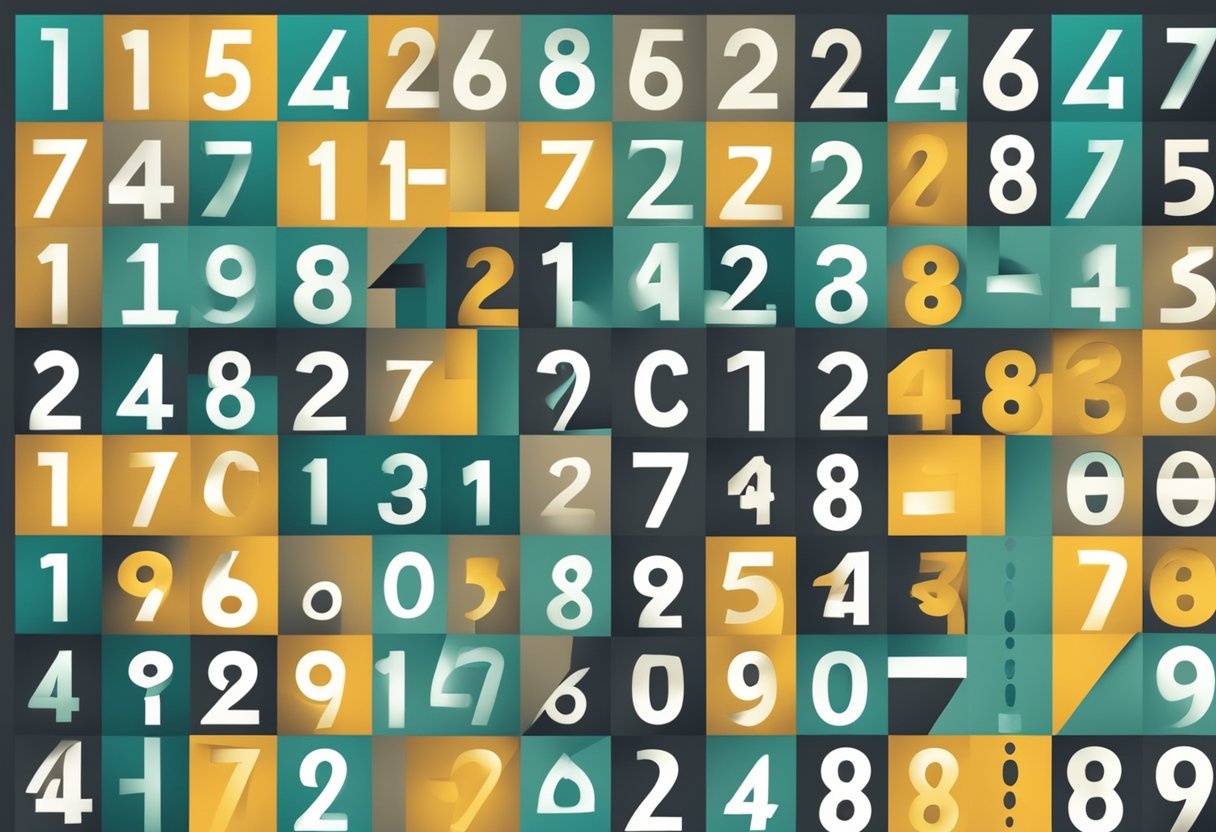JUMP TO TOPIC

To find a common difference in an arithmetic sequence, you should first identify any two consecutive terms in the sequence. The common difference denoted as $d$, is a key feature of an arithmetic sequence—essentially, it’s the constant amount you either add or subtract to any term to get to the next one.
For example, if I give you the sequence 4, 7, 10, your task is to subtract the first term from the second, or the second from the third, which here would yield $d=3$. This operation reveals the pattern the sequence follows and is the backbone of understanding its behavior.
The formula to calculate the common difference is straightforward: $d = a_{n} – a_{n-1}$, where $a_{n}$ is the $n^{th}$ term and $a_{n-1}$ is the previous term in the sequence. If I apply this to the sequence 2, 5, 8, the common difference is $d = 5 – 2 = 3$. By consistently adding this difference, I can predict future terms in the sequence or backtrack to find past ones.
As you see, once $d$ is determined, the entire sequence becomes much more manageable. If the sequence intrigues you and you want to explore how it unfolds or perhaps even craft sequences of your own, understanding $d$ is your starting point.
Understanding the Fundamentals of Arithmetic Sequences
An arithmetic sequence is a series of numbers in which the difference between consecutive terms is constant.

This constant value is known as the common difference, and it is a foundational characteristic of arithmetic sequences that sets them apart from other types of numerical series.
In the mathematical language, if I denote the first term of an arithmetic sequence as ( $a_1$ ), I can express the ( n )-th term of the sequence $a_n$ in terms of the first term and the common difference d. The formula to find the ( n )-th term is given by:
$ a_n = a_1 + (n – 1) \cdot d$
Here’s a simple list to illustrate what each symbol represents:
- ( $a_n$ ): The ( n )-th term in the sequence
- ( $a_1$ ): The first term in the sequence
- ( n ): The term position
- ( d ): The common difference
The sequence progresses in a linear fashion, meaning each term increases (or decreases, if ( d ) is negative) by a fixed amount set by the common difference, creating a predictable and steady pattern.
To determine the value of ( d ), I subtract any term in the sequence from the subsequent term:
$d = a_{n} – a_{n-1}$
It’s important to recognize that the common difference ( d ) can be positive, negative, or even zero. A positive ( d ) implies the sequence is increasing, while a negative ( d ) implies it is decreasing. If ( d ) equals zero, the sequence is not truly arithmetic, because all its terms are the same.
Understanding these principles is crucial for anyone exploring arithmetic sequences, as these fundamentals apply whether I’m dealing with simple patterns or complex mathematical problems involving sequences.
Steps In Finding the Common Difference In Arithmetic
When I’m dealing with an arithmetic sequence, one of the first things I like to find out is the common difference because it sets the pattern for the entire sequence. Here’s how I do it:
Identify the Terms: I start by identifying at least two consecutive terms in the sequence. For example, if I have the sequence 3, 7, 11, 15, the first term $ a_1 $ is 3, and the second term $ a_2$ is 7.
Subtract Sequentially: I then subtract the first term from the second to find the common difference (( d )). So, ( $d = a_2 – a_1$ ).
In my example, ( d = 7 – 3 = 4 ).
Confirm the Difference: To be sure I’ve got it right, I subtract the second term from the third $a_3$, and check that the result is the same.
Following through, ( 11 – 7 ) also gives me 4. This confirms that my common difference is indeed 4.
Use the Formula: For any term after the first, the formula ( $a_n = a_1 + (n – 1)d$ ) helps me calculate further terms using my found common difference.
Here’s a brief representation of what this looks like in a table:
| Term Position | Term Value | Operation | Result |
|---|---|---|---|
| ( n = 1 ) | 3 | – | – |
| ( n = 2 ) | 7 | ( 7-3 ) | 4 |
| ( n = 3 ) | 11 | ( 11-7 ) | 4 |
| ( n = 4 ) | 15 | ( 15-11 ) | 4 |
By following these steps, the solution to find the common difference is straightforward and easily replicable. With practice, spotting and solving for the common difference in arithmetic sequences becomes second nature.
Practical Examples and Solutions
When I come across an arithmetic sequence, I check for a constant difference between consecutive terms. Let’s say I have the sequence ( 3, 7, 11, 15, 19 ). I find the common difference (( d )) by subtracting a term from the one that comes after it. For example:
( d = 7 – 3 = 4 )
I confirm the common difference by checking other consecutive terms:
( d = 11 – 7 = 4 )
( d = 15 – 11 = 4 )
Since the difference is consistent, it’s an arithmetic sequence with a common difference of ( 4 ).
| Term (( n )) | Value | Difference (( d )) |
|---|---|---|
| 1 | 3 | – |
| 2 | 7 | ( 4 ) |
| 3 | 11 | ( 4 ) |
| 4 | 15 | ( 4 ) |
In another case, consider a decreasing sequence like ( 10, 5, 0, -5, -10 ). The common difference is negative:
( d = 5 – 10 = -5 )
The rate of change is ( -5 ), making the sequence arithmetic. To find the nth term (( a_n )) of an arithmetic sequence, I use the formula:
$a_n = a_1 + (n – 1) * d $, where ( $a_1$ ) is the first term.
Let’s apply this to find the 5th term of the sequence ( 4, 9, 14, … ):
$a_5 $= 4 + (5 – 1) * 5 = 4 + 20 = 24
Here are some practice problems for you to try:
- Find the common difference of ( 1, 6, 11, 16, … )
- Calculate the 10th term of the arithmetic sequence ( 2, 5, 8, … )
- Determine if ( -2, 1, 4, 7, … ) forms an arithmetic sequence and find the common difference.
Remember, arithmetic progressions are all about consistent increments or decrements, and the formula to find any term within them is straightforward once you’ve got the common difference down.
Conclusion
In this article, I’ve explored the process of finding the common difference in an arithmetic sequence. I started with defining an arithmetic sequence and explaining the significance of the common difference, denoted as d. Recalling that it represents the fixed interval between any two consecutive terms, I demonstrated how you can find it using the formula d = $a_{n} – a_{n-1}$, where $a_{n}$ is the nth term and $a_{n-1}$ is the (n-1)th term.
I also provided examples to help clarify the process of calculation. If you ever need to compute the nth term of an arithmetic sequence, simply use the formula $a{n} = a_{1} + (n – 1)d$, substituting $a{1}$ with the first term and n with the term position you’re interested in.
Remember that understanding the common difference is key to mastering arithmetic sequences and will assist you in solving various mathematical problems. It’s a fundamental concept that supports patterns and progressions in mathematics.
Through practice and application, you’ll find that working with arithmetic sequences becomes straightforward and almost second nature.
